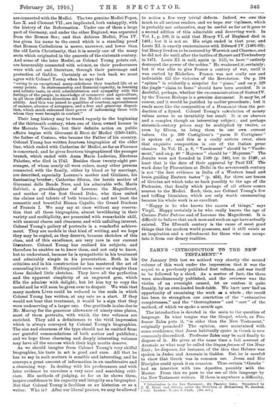ZAIIN'S "INTRODUCTION TO THE- NEW TESTAMENT." * ON January 29th
last we noticed' very shortly 'tile second'
volume of this work under the impression that it was the sequel to a previously published first volinne, and was•itself
to be followed by a third. As a- matter of fact; the three
were simultaneously published, and the reviewer was the victim of an oversight caused, let us confess • it quite
frankly, by an over-loaded book-table. We have' now'had'an opportunity of examining the work as- a whole ; the-result has been to strengthen our cohviction of' the "exhaustive completeness," and the "thoroughness-" and " care " of' the method, of which we spoke a month ago.
The introduction is devoted in the main to the question of language. In what tongue was the Gospel, which, as Pro- fessor Zahn puts it, "is older than the New Testament," originally preached ? The opinion, once maintained" with. some confidence, that Jests habitually spoke in Greek is now commonly discredited. Professes Zahn may said finally to
dispose of it. He gives at the same time a full" account of Aramaic as what may be called the lingua franca.of the Near East ; he disposes, for instance, of the idea that Hebrew' was spoken in Judea and Aramaic in Galilee. Bat, he is careful. to show that Greek was in common use. Jesna. and His Disciples could speak it on occasion. Thus ,eertain '!,Greeks " had an interview with two Apostles, possibly with the Master. From this we pass to the use-of- this language-by the New Testament writers. If there is anywhere a .difficulty, " Introduction to the New Testament.- .By'- Tlaeador Zsdur. Translated by J. M. Trout and Others, under the Direction of xeasstaso; mr,. Jacobus. 1; vols. London : T. and T. Clark. [36a. net.] it would,be as regards the Epistle of James. And here it is of the very slightest. The Head of the Jerusalem Church, necessarily bilingual, during his many years of office could hardly have failed to become familiar with the language. Of St. Paul's proficiency in it Professor Zahn has formed a high estimate. St. Paul employs it with "versatility and effect." He does not use it as a language "acquired with effort late in life." He is evidently familiar with rhythmical effect. It is im-
_CITE
possible to read such passages as 1 Cor. ix. 24-27: O_K O TB 3ii 01 ir cfredieo and the famous encomium of charity, without feeling this. Professor Zahn has something to say about the much-disputed quotation from Menander (1 Cor. xv. 33). The metre requires xpiee% whereas the received text has xiniaTcl. What does this indicate ? Copyists often lost the poetical form ; so where Justin (Apol. I. 39) evidently quotes the Euripidean 7k5tre OIAL0X.. the copyist has given yaaeas ha4aomee- It is possible, however, that the form was deliberately altered as suggesting incongruous associations.
In dealing with the several books a chronological order has been followed. The Epistle of James comes first, and the date assigned is of the very earliest. It was addressed, our author holds, to the Christian Church in the year 50, while its membership was still almost entirely Jewish. He sees "clear traces of its influence upon the Christian writers of the period immediately following the year 50." It is certainly easier to deal with the well-known opposition between James ii. 14-26 and Romans iv. 1 ff., re justifi- cation, if James is taken as the earlier of the two writers. Professor Zahn's treatment of the subject is most interesting and instructive.
Passing on rapidly, as considerations of space compel us to do, to•2 Corinthians, we find Professor Zahn combating the critical theories in which it is maintained either that the letter, as we have it now, is a conflation of two letters, or that circumstances brought about a sudden change of temper in the writer while it was in process of composition. He regards it as "a unit with an order which is both natural and logical." This thesis he argues with great ability, and with the thorough mastery of detail which is characteristic of his work ; but we must own that he does not convince us.
In the third volume we find an able defence of the theory which supposes that the same author wrote the Third Gospel and Acts, that this author was Luke the beloved physician, and that this physician was a Greek by birth. Here are some of the minutiae which are so profoundly interesting. In the description of Jesus's healing work Luke is more detailed even than Mark, though elsewhere he omits unnecessary particulars. He changes, too, the order of the details. After the healing of Tairus'e daughter Mark puts the injunction of silence first, the direction to give food second. St. Luke regards the second as immediately the more important, and puts it first. He avoids, again, non-technical words, such as paAcucia, in medical matters. He follows, also, the medical writers in using IrapaitEXUALEPOS for irapakevuebs.
On the profoundly important point of the authorship of the Fourth Gospel Professor Zahn holds a most decided opinion that it is Apostolic. The belated question of "how much freedom Jahn allowed himself in the reproduction of the discourse" cannot, he thinks, be definitely answered. But he holds that one who writes from his own knowledge would feel more at liberty to interpret than one who was writing from the accounts of others. As he believes in the Apostolicity of Matthew's Gospel also, this does not help us much.
We have seen nothing to alter our view that the con- servatism of Professor Zahn is somewhat extreme; but we cannot speak too highly of his thoroughness and his learning.











































 Previous page
Previous page